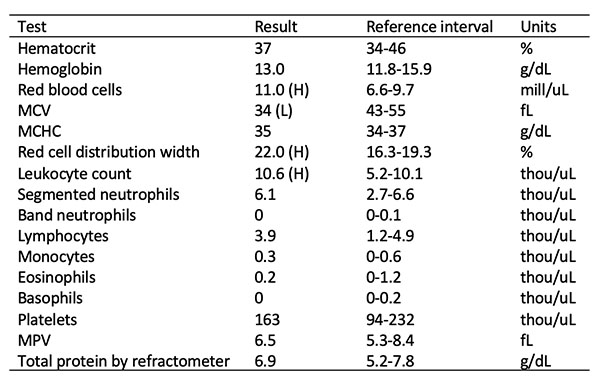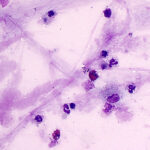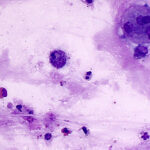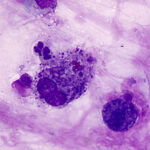Tracheal wash aspirate from a 4 month old foal
Case Information
A 4-month-old Standardbred filly was presented to Cornell University’s Nemo Farm Animal Hospital for a recheck of right carpal valgus, which was diagnosed a month prior at Cornell. The owners had chosen to treat the angular limb deformity with corrective shoeing.
Upon physical examination, the foal was bright, alert, and responsive. Temperature, pulse, and respiration rate were within normal limits and mucous membranes were pink and moist with a capillary refill time of 1-2 seconds. The right carpal valgus with external rotation remained, but the foal was ambulatory without joint effusion or pain on long bone palpation. A bilateral serous to mucoid nasal discharge with bilaterally enlarged mandibular lymph nodes (right larger than left) were also detected. The client indicated that these signs had not been seen previously. Based on these findings, the foal was hospitalized for possible respiratory disease.
During the day and overnight, the foal continued to nurse well, eating and drinking normally. The next day, a persistent cough was noted. Lung sounds were mildly harsh cranioventrally with little nasal discharge. Nostrils were bilaterally patent, with normal bronchovesicular sounds over the trachea. Thoracic radiographs and ultrasound confirmed mild bilateral cranioventral disease, with an interstitial-to-alveolar pulmonary pattern. Results from the hemogram are shown below. A fibrinogen by heat precipitation was 300 mg/dL (0-200 mg/dL). Serum Amyloid A (SAA) concentrations were < 5 ug/mL (reference interval, <5 to 20 ug/mL).

A transtracheal wash was performed and samples were submitted for cytologic examination and bacterial culture. Modified Wright’s-stained sediment smears of the fluid were examined (Figures 1-3).
View the provided images then answer the questions below.
 |
 |
 |
- What are your differential diagnoses based on the cytologic findings in smears of the tracheal wash?
- What further tests are indicated?
Answers on next page
